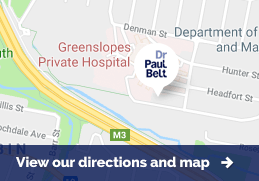The Procedure
Radical Abdominoplasty
A classic abdominioplasty is also known as a radical abdominioplasty.
An abdominoplasty (or tummy tuck) is the removal of any excess skin and fat from the lower abdomen as well as repairing the muscle separation of the anterior abdominal wall. These may be causing problems with the skin - including infection and dermatitis. This may be associated with people who have lost a large amount of weight or women who have had previous pregnancies.
Any separation of the rectus abdominis muscles can be retightened and corrected. This will result in improved abdominal tone which may be resistant to usual toning techniques. This would also improve the weakness as well as enhancing the appearance of the muscles of the abdominal wall.
Repairing the separation of the rectus abdominis muscles will also lead to an increase in core strength. Many patients also feel that back pain may be improved. Furthermore, some stress and urge incontinence of urine may be reduced by having this muscle repair performed. Abdominoplasty also helps to create a more “normal” appearance to the abdomen by removing the excess apron of skin and fat.
Any abdominal hernia or bulges that are present will also be repaired at the time of surgery. The operation may involve removal of the skin and adipose (fat) tissue that is excessive. Classically the skin and fat are removed. The umbilicus is islanded and left in place and then the skin is mobilised around it to create a new hole for relocation of the umbilicus. A new umbilical position may be relocated into an aesthetically ideal position.
All patients have the procedure performed as an inpatient and remain in hospital for two to five days. Most patients are discharged home without drains which are removed during their inpatient stay.
Goals of abdominoplasty (tummy tuck)
- To create a more normal appearance of the abdomen.
- Repair any abdominal herniae that may be present.
- Removal of the apron of excess skin and fat.
- Improvement in abdominal muscle tone and shape.
- Revision of any existing scars.
The operation may involve approaching only the skin if this is the only element that is excessive. It may progress to performing excision of skin, fat as well as mobilisation of the umbilicus. Usually an incision is made in the lower half of the abdomen and abdominal skin is removed between this incision all the way up to the umbilicus. The skin above this is then undermined allowing it to be pulled down to meet lower incision. A new umbilical position will be relocated in an aesthetically sensitive manner. Before the skin is closed the underlying muscles are surgically tightened with stitches. Drains are then placed and the skin is stitched together using dissolvable stitches.
From 1st January 2016 Medicare has imposed restrictions on the use of the item number for Abdominoplasty (including the mini and vertical abdominoplasty). In order to qualify under the new Medicare guidelines it is important that patients fulfil the following criteria:
- There is intertrigo (severe rashes and skin ulceration) or another skin condition that risks loss of skin integrity and has failed three months of conventional (non-surgical) treatment
- The excess skin interferes with the activities of daily living
- The weight loss is equivalent to a loss of 5 BMI (body mass index) point which has been stable for at least six months
There are alternative options including a mini abdominoplasty and a vertical abdominoplasty.
Mini-Abdominoplasty
A mini abdominoplasty is indicated in patients who have a moderate degree of excess skin in the lower abdomen.
It is also suited to women who have separation of their rectus abdominis muscles below the umbilicus.
The procedure involves making an incision which is smaller than that of a standard radical abdominoplasty in the area above the pubic bone. The skin is undermined up to the umbilicus and the separation of the muscles below the umbilicus is corrected. The excess skin is then removed.
This procedure is also helpful in correcting the bulge which can be present above a lower horizontal scar, such is the case after a caesarean section.
Dr Belt will be able to advise you at the time of your consultation if you are a suitable candidate for a mini abdominoplasty or, if the degree of skin you have is beyond the scope of this operation and/or your muscles require repair up to the ribcage (xiphisternum), then this technique may not be powerful enough in which case a radical abdominoplasty would be a more effective procedure.
Vertical Abdominoplasty
In patients who already have a midline scar from previous surgery (e.g laparotomy), a vertical abdominoplasty may be an option to avoid the need for additional scarring. This technique may also be an option for patients with a large hernia or extremely thin skin.
Combined Abdominoplasty with Abdominal Liposuction
It is possible in selected cases to perform liposuction at the same time as an abdominoplasty.
It is generally recommended that patients obtain their goal weight prior to surgery and the surgery is general performed after patients have lost weight and their weight is stable. However, there are situations were patients may still have some areas of excess adipose tissue that have not responded to weight loss. These areas can be dealt with either a staged procedure having liposuction prior to an abdominoplasty, or alternatively, can have the two surgeries performed at the same time.
The central upper abdomen is where the blood supply to the flap raised for an abdominoplasty obtains its blood supply. For this reason it is generally not safe to perform liposuction to the upper part of the abdomen. Other areas on the abdomen and torso are safe areas to perform liposuction simultaneously with an abdominoplasty.
The area that responds best is generally the outer part of the upper abdomen (flanks) extending onto the lower back.
Dr. Belt will be happy to advise if you are a suitable case to have the combined procedure.

Complications and Risks
All Procedures have potential complications and risks. These can be divided into general complications and those specific to each procedure. The latter are listed in the FAQs below.
General complications include:
- Wound complications - bleeding, bruising, collections under the skin of blood (haematoma), pus (abscess), serous fluid (seroma), infection, wound breakdown, suture extrusion, sensory loss;
- Aesthetic complications - poor scars, stretched scars, raised scars (keloid or hypertrophic), contour irregularities, need for revisional procedure;
- Anaesthetic complications
FAQs
-
What are the potential costs involved?
Dr Belt’s fee, an assistant’s fee, theatre fee, day bed and price of overnight accommodation, specialist anaesthetist fee and the cost of two support garments.
Our fees attract rebates from Medicare and Health Funds, please contact Dr Belt’s rooms for a specific quote.
-
What are the potential risks?
These can be broken down into those general risks for any procedure and those specific to the procedure.
Specific risks include asymmetry both in scars, umbilicus and the skin contour, loss of fat and skin (necrosis), wound breakdown, collections of fluid underneath the skin including serum (seroma), blood (haematoma), pus (abcess), damage to the deeper underlying intra abdominal organs and permanent numbness of the lower abdominal skin.
Smoking will significantly increase the risk of these complications as does obesity.
It is important that a patient’s health is maximised before surgery to minimise these risks. This includes ceasing smoking at least three months before the surgery. In addition, if one can obtain the ideal weight prior to surgery then the benefit of the operation is maximised. Subsequent alterations in body weight including gain and reduction may reduce the long terms effects of the abdominoplasty.
General risks include bruising, swelling, bleeding, wound infections, anaesthetic related problems and problems related to abnormal scarring (hypertrophic, keloid & stretched scar).
Liposuction to the centre of the abdomen is not performed at the time abdominoplasty as this increases the risk of wound related problems. It is possible however to perform liposuction to the flanks “love handle’ area as this area is not directly involved with the surgery and does not increase the operative risks.
-
What happens after the surgery ?
This surgery is usually performed as an inpatient and patients can be expected to stay at least one night in hospital. Drains will be inserted into the wounds which exit below the wound through the midline of the abdomen just above the mons area. These may stay in for a number of days after surgery if the drainage is excessive. Most patients have the drains removed 3-5 days after the surgery. You will be expected to wear a support garment around the abdomen for a period of six weeks. You will be seen daily whilst an inpatient then at regular intervals usually for a period of 12 months.
-
What type of anaesthetic is used?
Dr Belt will only perform this surgery under the control of a General Anaesthetic administered by a specialist anaesthetist.
-
Is it possible to combine abdominoplasty with other procedures?
It is possible to perform an abdominoplasty with multiple other procedures. These may include breast surgery (augmentation, reduction and lift/mastopexy). The advantage of combining these procedures is that it leads to a complete transformation of the appearance of the anterior part of the torso. There may also be significant cost advantage to the patients by combining procedures.
Please refer to the section on combined abdominoplasty and breast augmentation, combined abdominoplasty and breast lift, and combined abdominoplasty and breast reduction.














